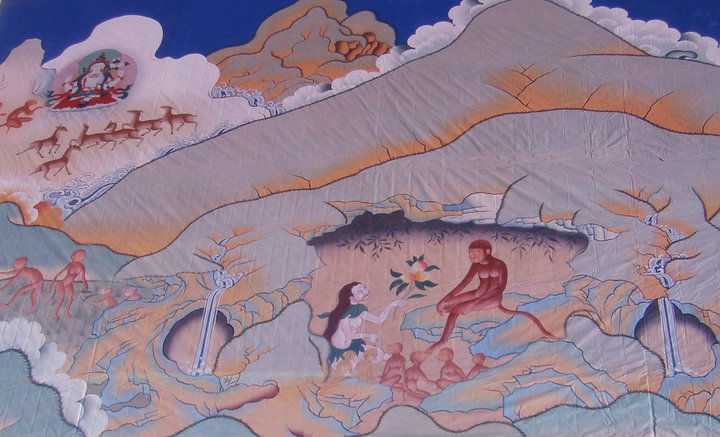Buddhist narratives and "Tibetan" ethnogenesis

This project traces the history of what today is still the most popular origin myth of “the Tibetans” (Tib.: bod pa), which traces their ancestry back to a union between a saintly monkey and a blood-thirsty rock-demoness. The project examines the role that Buddhism played in molding and propagating this narrative, and how this helped shape and solidify the ethnic category of “the Tibetans” over time. Spanning some seven centuries (from the 12th to the early 19th c.), the research addresses ongoing interdisciplinary debates on the nature and prevalence of inter-regional identities prior to the age of modern nationalism. Theoretical issues at stake are the social salience of such identity constructs before this period, as well as the relative roles that religion, myth and states played in their formation and promotion.
The hypothesis is that the Buddhist circulation of this narrative helped propagate and sustain the notion of “the Tibetans” even during long absences of centralized state power. Related research questions include: How exactly was this origin narrative used, and how did it change across time and space? How widespread and well-known was it? What roles did Buddhist authors and actors play in Tibetan ethnogenesis, and how contested was this process?
The primary focus will be a philological endeavor to chart the literary usage and narrative developments of this early origin myth. Attested as early as the 11th or 12th c. CE in the bKa’ chems ka khol ma, it reappears, in various permutations, in countless further sources. In a bid to shed light on the ritual dissemination and geographic spread of this narrative, selected other works will be examined as well, above all eastern Tibetan ancestor cult manuals and biographies. Ethnographic fieldwork, moreover, will examine the role of material culture and pilgrimage in its propagation. The project thus combines philology, social history and, to some extent, ethnography.
By harnessing the rich and deep Tibetan historical record, the project will make innovative contributions to theoretical issues regarding historical ethnicity and identity that have proved consistently thorny across academic disciplines. Within Tibetology, it will contribute to existing historical scholarship, which up to date has largely ignored the early history of the idea of “the Tibetans.” In contrast to earlier studies, this project will analyze the relevant sources as active contributors to the construction and adaptation of a malleable identity. In the process, it will also address text-critical questions concerning key historical works such as the bKa’ chems ka khol ma.
The main researcher, Reinier Langelaar, has conducted research on Tibetan communities from a range of perspectives, using historical, philological, ethnographic and comparative methods. His PhD focused on clan genealogies and included an extensive analysis of a non-Buddhist ethnic origin narrative. The project leader, Pascale Hugon, is an expert on Tibetan Buddhist literature and intellectual history.
Project Data
- Head: Pascale Hugon
- Research: Reinier Langelaar
- Field: Tibetan Studies
- Running period: 2021–2025
- Funding: FWF P34212-G